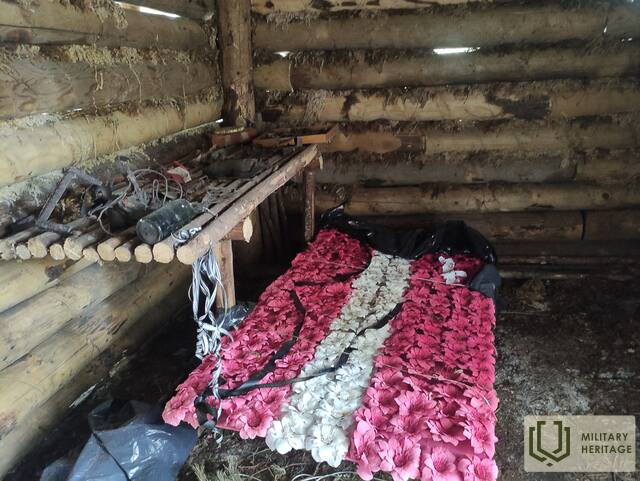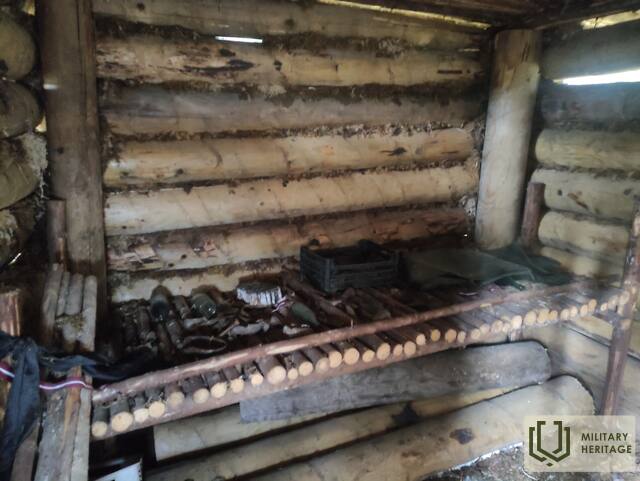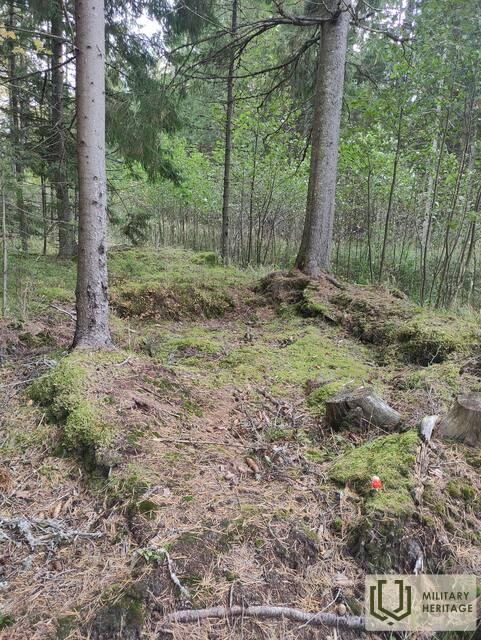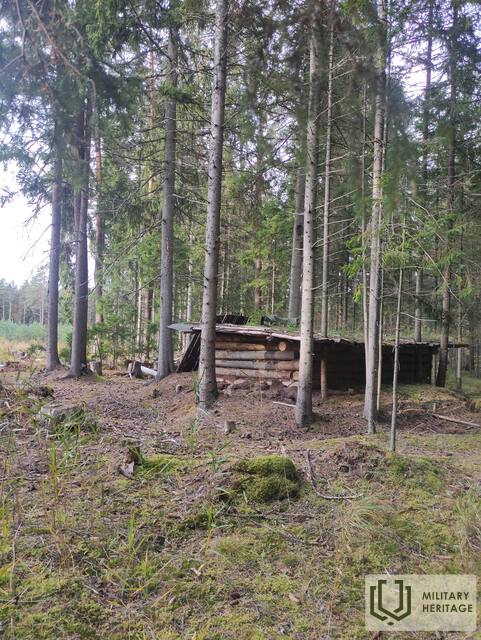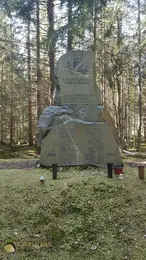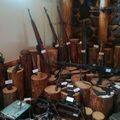Die Schlacht von Dzelzkalni im Zūri-Wald am 23. Februar 1946
Den Winter 1945/46 verbrachte die Gruppe „Brass“ im Wald von Zūri bei Dzelzkalni, wo mehrere Bunker errichtet worden waren. Dort lebten etwa 40 Partisanen. Am 23. Februar 1946 wurde das Lager von Truppen des sowjetischen Innenministeriums umstellt, und es kam zu einem heftigen Gefecht.
Im Gebiet Dzelzkalni im Wald von Zūri wurden mehrere Bunker für die nationale Partisanengruppe Misiņš errichtet. Dort lebten etwa 40 Partisanen. Die Gruppe gab damals ihre eigene Zeitung „Kurbads“ heraus, die vom ehemaligen Kriegsberichterstatter Pēteris Arvīds Šāvējs redigiert wurde.
Am 23. Februar 1946 wurde das Lager von sowjetischen Militärtruppen umstellt. Im Kampf um die Befreiung fielen acht Partisanen. (Laut dem damaligen Kontaktmann der Gruppe, Tālivaldis Bāliņš, blieben sechs der Gefallenen am Ort des Geschehens zurück, während zwei von den Tschekisten abgeführt und an einem unbekannten Ort begraben wurden. Den Grabsteinen auf dem Friedhof der Brüder Dzelzkalni zufolge sind jedoch sieben der am 23. Februar Gefallenen dort begraben.) Dem Rest der Gruppe gelang der Ausbruch aus der Belagerung, indem sie zwei kommunistische Maschinengewehrbesatzungen ausschalteten, die den möglichen Rückzugsweg der Partisanen abschneiden sollten. Anschließend teilte sich die Gruppe auf: Ein Teil zog in die Wälder von Kabile, zwei Partisanen nach Ventspils, und der Rest erreichte nach Überquerung der Straße Ventspils-Riga und des Flusses Rinda Puzes Bētmeji.
Oberstleutnant Rūdolfs Opmanis, Student im dritten Studienjahr der Landwirtschaftsakademie Pēteris Šāvējs, Elektrotechniker Jānis Sēkliņš, Student im dritten Studienjahr der Medizinischen Fakultät Lūdolfs Kļava, Absolvent der Handelsschule Alfrēds Grāvelsiņš, Försterlehrling Bruno Auers, Absolvent der Rechtswissenschaftlichen Fakultät Maksis Ķierpe und Roberts Krastiņš fielen in der Schlacht vom 23. Februar. Sechs von ihnen wurden im Frühjahr 1946 von Partisanenanhängern an derselben Stelle im Dorf Vārnu beigesetzt. Die Grabstätte der gefallenen Partisanen wurde während der gesamten Besatzungszeit immer wieder von den ugalischen Imants Kalnenieks gekennzeichnet.
Lettische Soldatenfriedhöfe und Gedenkstätten: Pfarrei Ugāle, nationaler Partisanenfriedhof in der Nähe von Dzelzkalnie (karavirukapi.blogspot.com)
Zugehörige Zeitleiste
Zugehörige Themen
Zugehörige Objekte
Grab der Nationalen Partisanenbrüder „Dzelzkalni“
Auf dem Friedhof wurde ein Denkmal zum Gedenken an die Partisanen errichtet. Die Namen der Partisanen der Partisanengruppe Puze-Piltene sind in den Stein eingraviert. Die Granitplatte am Fuße des Denkmals trägt die Jahreszahlen (1945–1953) und die Namen von 36 gefallenen Partisanen.
Am 23. Februar 1946 fand in der Gemeinde Tārgale bei Vārnuvalkas eine blutige Schlacht zwischen der lettischen Partisanengruppe unter Kommandant Brīvnieks in ihrem Lager und einer Zerstörereinheit der sowjetischen Besatzungsarmee statt. Sechs Partisanen fielen in der Schlacht und wurden von Anwohnern heimlich im Wald begraben. Später wurden zwei weitere, erschossene Männer dort ohne Gerichtsverfahren oder Verurteilung beigesetzt. Dieser Teil des Waldes wurde in der Gegend als Dzelzkalns-Friedhof bekannt und war viele Jahre lang nur Kennern an dem Kreuz in der Fichte zu erkennen.
Im Sommer 1989 stellten Mitglieder des Ugāle-Zweigs der Lettischen Nationalen Befreiungsarmee (LNNK) Birkenkreuze auf der nationalen Gräberstätte der Puze-Piltene-Gruppe der am 23. Februar 1946 Gefallenen im Gebiet Dzelzkalni im Wald von Zūri auf und suchten in Lettland und im Ausland nach Angehörigen der Gefallenen.
Am 27. April 1991 wurden die Gräber unter Beteiligung von Angehörigen der Gefallenen und Vertretern nationaler Organisationen aus mehreren Ländern von Theologieprofessor Roberts Akmentiņš geweiht und erhielten den Namen „Gräber der Brüder Dzelzkalni“.
Museum der nationalen Widerstandsbewegung in Renda
Das Museum liegt nur einige Kilometer vom Ortskern von Renda entfernt. Die Ausstellung ist der fünfzigjährigen Geschichte der Widerstandsbewegung in Lettland gewidmet: Widerstand gegen die erste sowjetische Besatzung, die nazideutsche Besatzung, bewaffneter und gewaltfreier Widerstand gegen die zweite sowjetische Besatzung. Die Ausstellung ist in zwei Gebäuden untergebracht. Eines birgt Zeugnisse der ersten sowjetischen und der deutschen Besatzungszeit. Die Ausstellung in der renovierten Scheune ist dem nationalen Partisanenkampf gewidmet. Zwischen den beiden Gebäuden liegt ein Bunker mit authentischer Einrichtung und Schützengräben. Das Museum umfasst auch Laufgräben, Unterstände und einen Hindernisparcours zur körperlichen Betätigung für Besucher. Ein Museumsbesuch sollte im Voraus vereinbart werden.
Im Januar 1946 fand ganz in der Nähe eine der größten Kampfhandlungen der nationalen Partisanen statt, die sog. Schlacht von Āpūznieki, in der sich die nationale Partisanentruppe von Kabile einer großen Übermacht von Kräften der sowjetischen Besatzungsmacht erfolgreich entgegenstellte. Am Schauplatz der Kämpfe wurde ein Rastplatz mit Informationstafeln angelegt.




